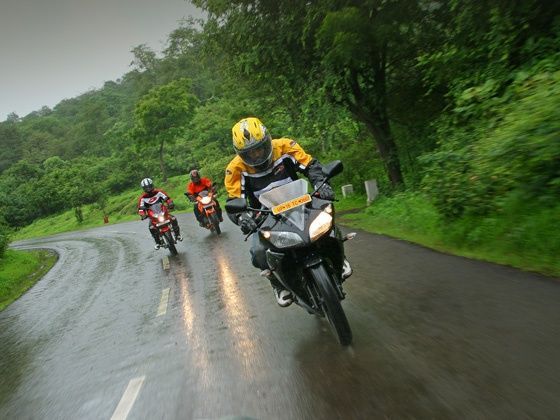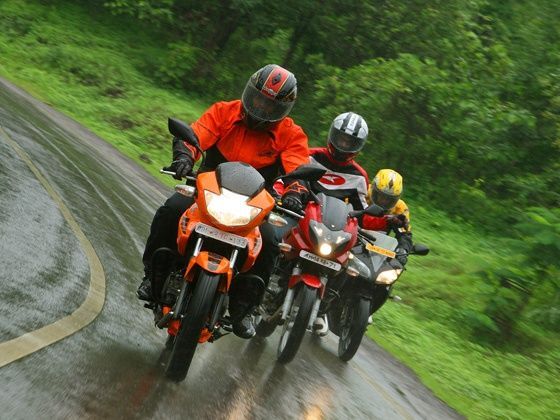As inviting as it may seem, riding during the monsoon can be very tricky business especially owing to slippery roads, low visibility and a lot of other factors. A few tips to keep in mind for riding in the monsoon
Statistics reveal maximum numbers of accidents occur during the monsoon. Riding in the monsoon can be extremely fun as long as you know the tricks of the trade. The first rains bring along with it the beautiful smell of wet and fresh mud, something that we all love. But along with this boon comes a bane. Throughout the year, any form of oil or coolant which has leaked on the road is soaked in by the road. This oil surfaces in the first rains making even the best of roads slippery and risky. It is advisable not to go fast or probably even halt for a cup of tea if you can at such times.

Maximum of accidents occur during the monsoon season. Keeping safe distance is very important
Secondly, the visibility during a downpour is reduced by a massive margin not just owing to the drops of water falling on your visor but also sometimes due to fog. When put in a same scenario on wet roads versus dry, one needs much more time to react on a wet rainy road than otherwise, mainly for the reason that you can’t brake as hard on a wet road lest you lose grip and you bike ends up losing traction resulting in an eventual nasty slip. Always make sure that you keep an extra margin for error and brake in advance than you generally would.
Speeding through a puddle may remind you of your childhood days when you used to pedal your cycle through and have fun while the water splashed on your body, but this can be highly risky on a bike. Considering the shape of most Indian roads, it can be a high possibility that the puddle might be hiding a pothole underneath which may catch you unawares. Avoiding puddle or slowing down for unavoidable ones is the best thing to do.
Do NOT follow another vehicle very closely especially a car. Following a car is one of those ‘never ever do’ things. The potholes that the car misses between the width the left and right wheel may come as a dangerous surprise to you. Additionally, the muddy water splashing from its rear may further reduce your vision, and may not give enough time for you to react in case the vehicle ahead hits the brake in an emergency. Keep safe distance. Also, always keep a cleaning cloth with you when riding in the rain, to clean your visor, head lights and brake lights each time you take a break.

Keep your headlights on at all times to make yourself visible to oncoming traffic
Making yourself as visible as possible for other vehicles is as important as your visibility up head. To ensure this you can fix additional hazard lights/blinkers which should be kept on whenever visibility is low. You should also keep your headlights on at all times to make yourself visible to oncoming traffic.
Lastly, ride with all your gear on, which includes a waterproof jacket, gloves and boots, and protective pads for your knees and shin. In fact these are must haves every time you ride and not just during monsoons. A good helmet with a clear non-tinted visor is very important. Applying wax on the visor of your helmet can help the water to drip down faster and make visibility slightly better.
No comments:
Post a Comment